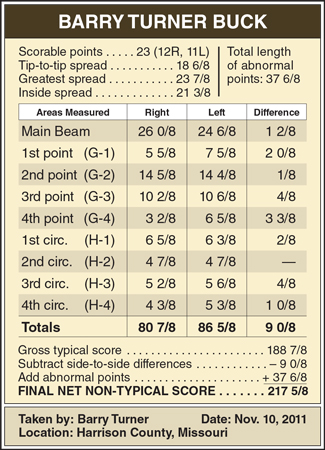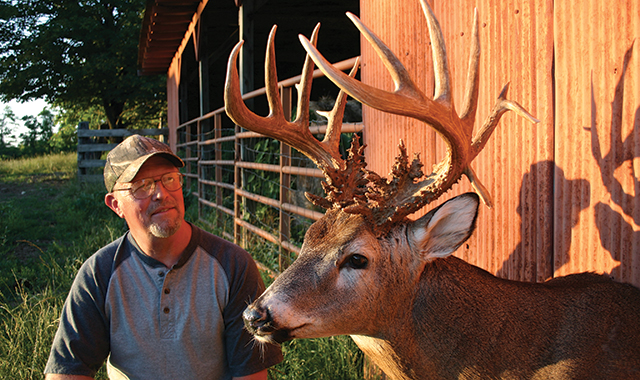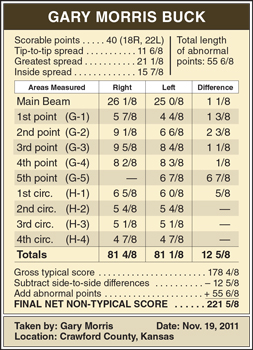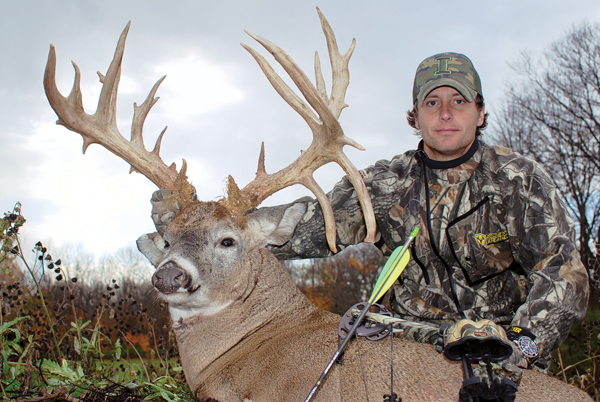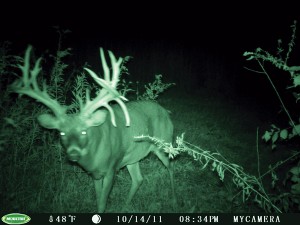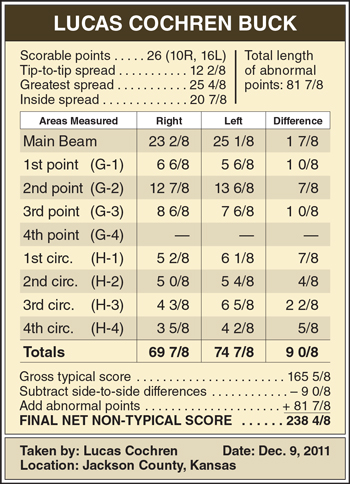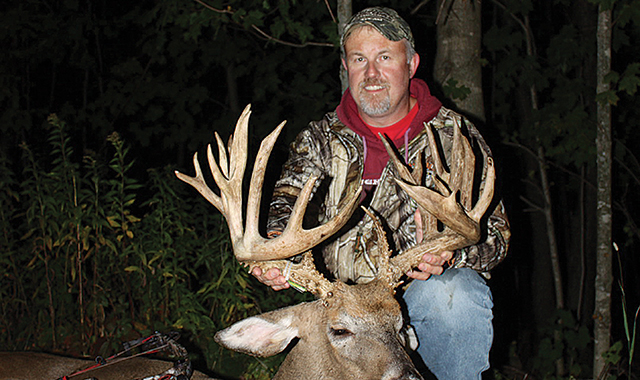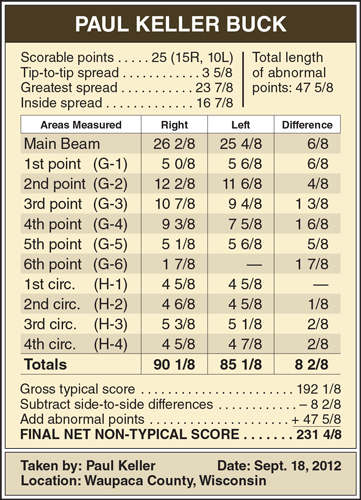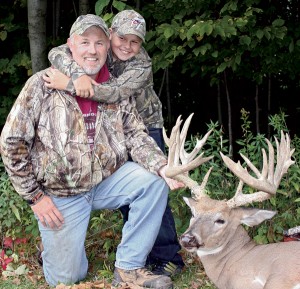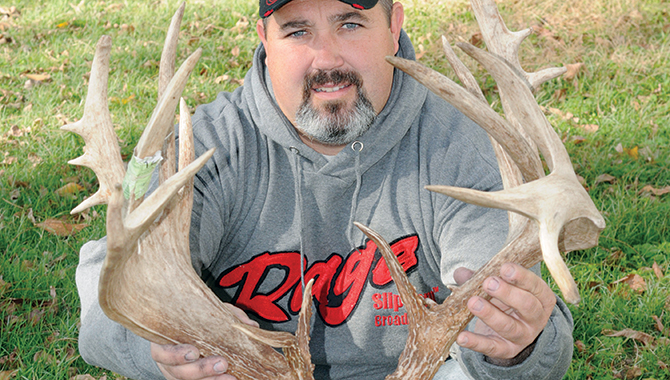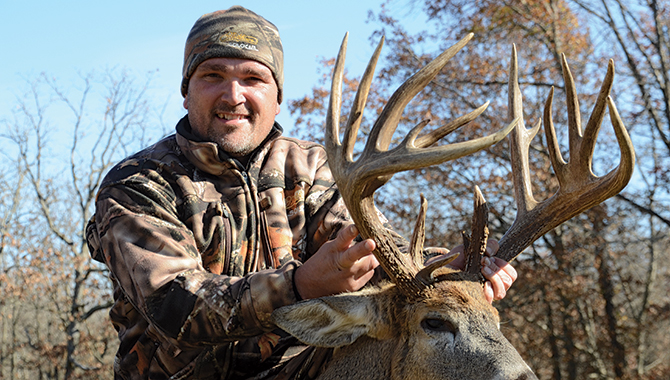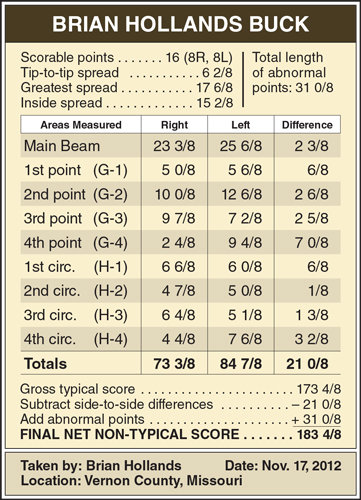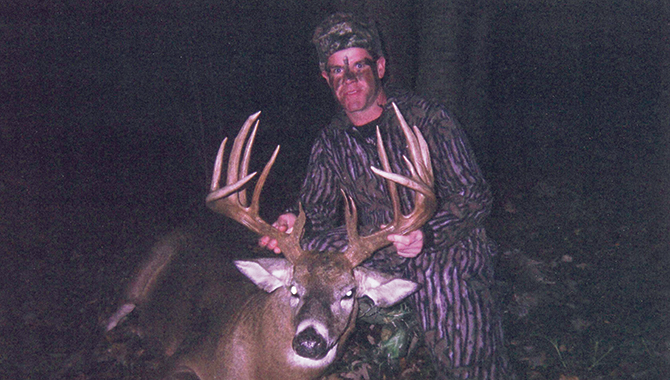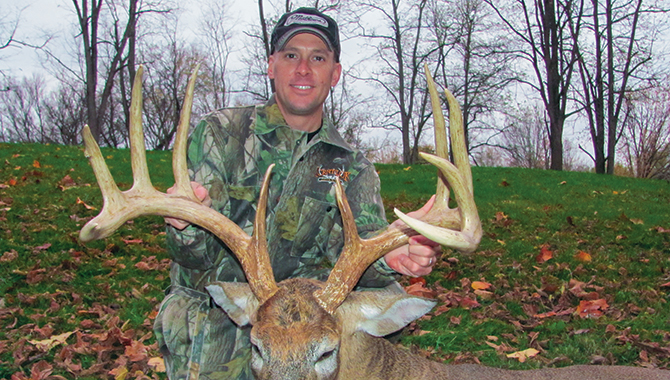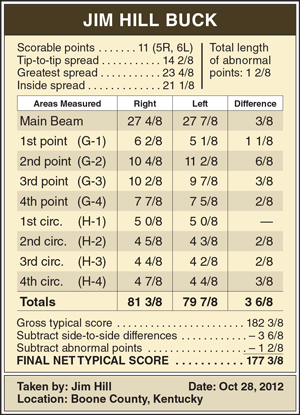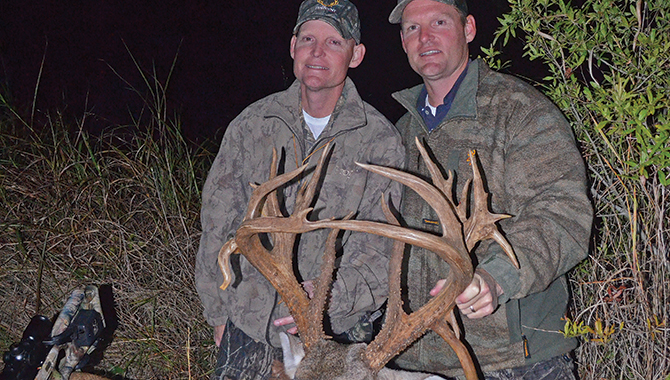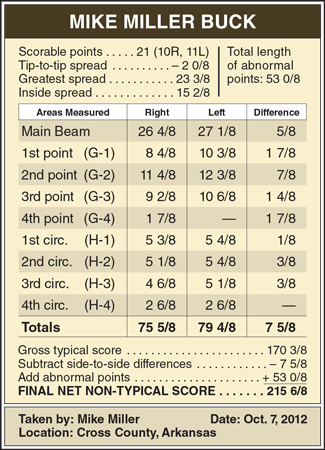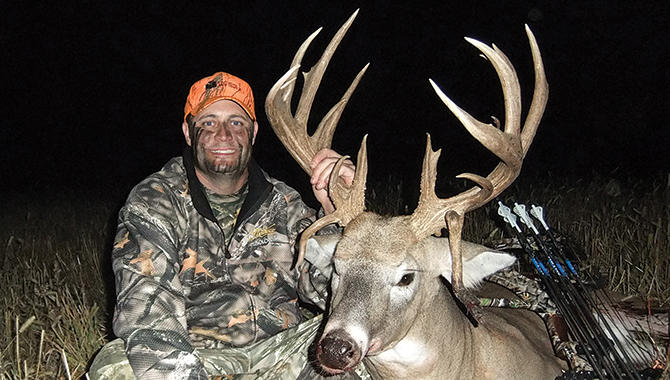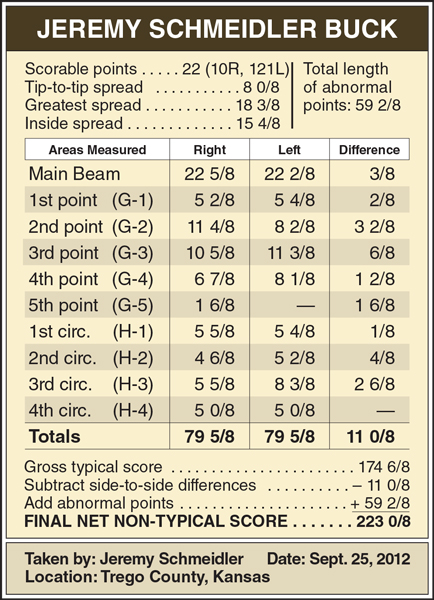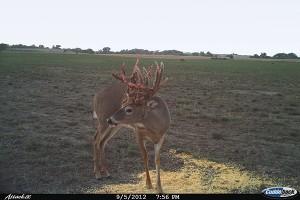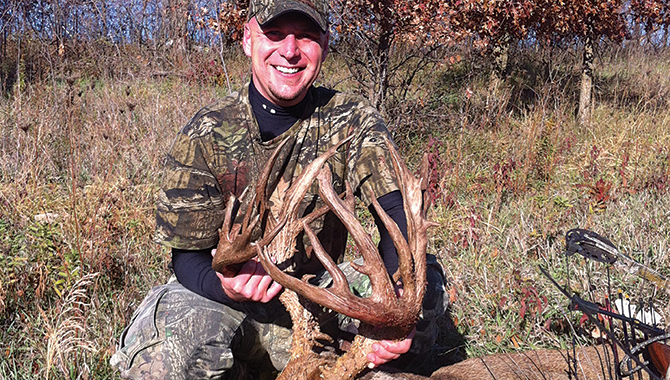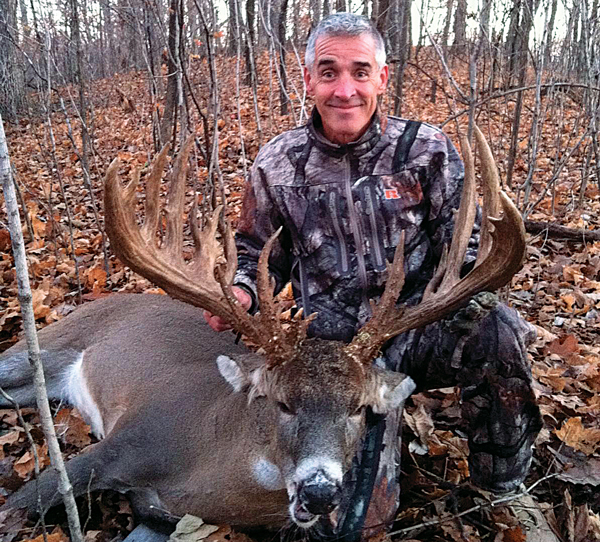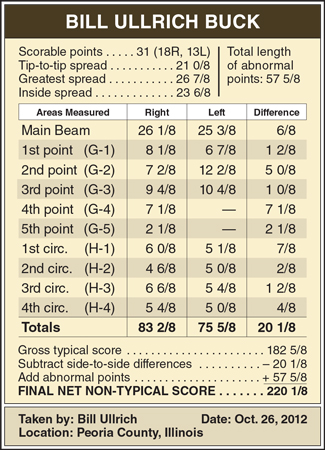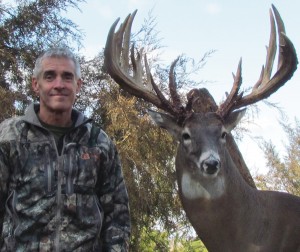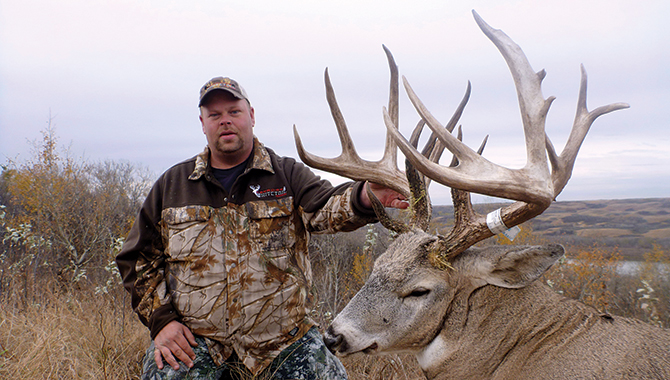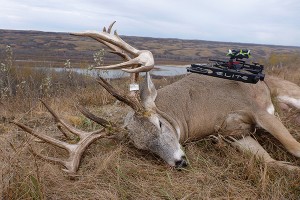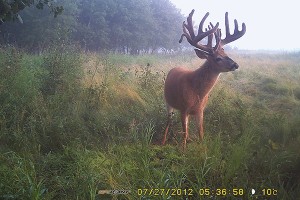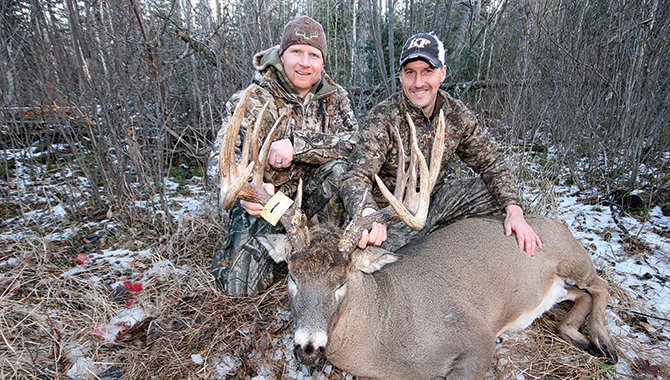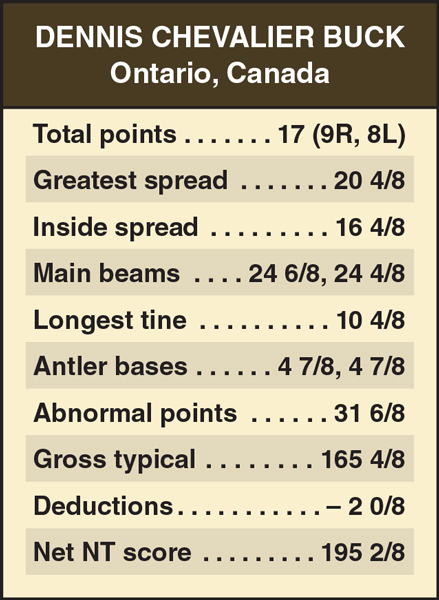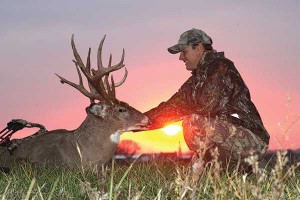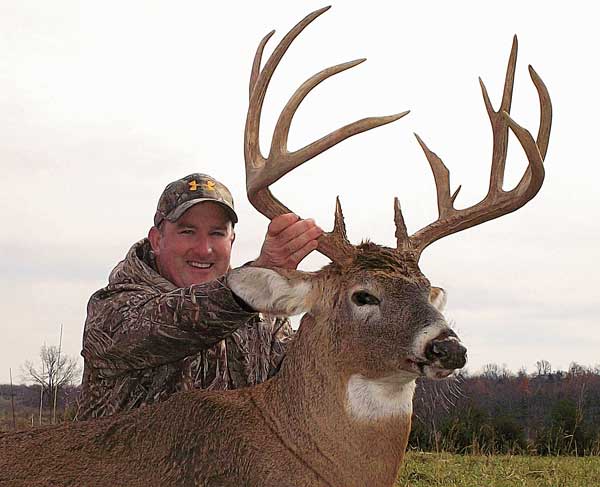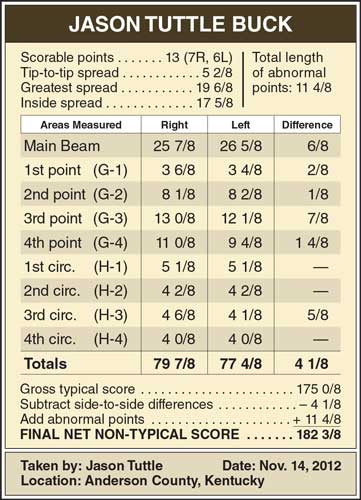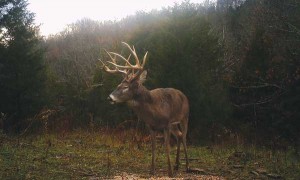![dean_partridge]() For as long as I can remember, hunting whitetails has been more than a pastime. It’s simply been my life.
For as long as I can remember, hunting whitetails has been more than a pastime. It’s simply been my life.
Chasing mature bucks was not just something we did, but something that defined who we were. The whitetail woods is where I’ve always felt at home, and my heroes have always been deer hunters.
My father was a man who just understood whitetails. He could walk onto a property, survey the lay of the land and walk over to a tree and say, “This one, Deaner. Get the stands. This is the tree to set up in.” It seemed effortless for him. Year after year, I watched my dad take fantastic bucks. By the age of 55, he had some 35 Pope & Young whitetails to his credit, but Number 36 was the most special of all of his P&Y bucks to me.
By that time, I was filming our own hunts, or at least trying to film them. That year, on a cold November afternoon, everything was perfect. It was just one of “those days.” That evening, I filmed my father take a tremendous, old 160-class 4×4 with his bow. My father never set foot in the whitetail woods again. Shortly after sharing that hunt with me, at far too young an age, my hero passed away. My father spent his life in the deer woods and was one of the most successful whitetail bowhunters I have ever known, but in all his years, he had never had an opportunity at a truly “once-in-a-lifetime” whitetail.
The following deer season without dad was difficult, but that just drove me to spend more time in the woods hunting, continuing to live our passion. I was hunting with my dad’s old friend, Steve Csizmar. Like my father, Steve’s passion was the deer themselves—not just the size of the rack or the score, but a love and appreciation for this incredible animal.
That same appreciation led me back to filming, so that I could share with others what we loved so much. I was fortunate enough to have a good friend, Jason Peterson, who produces a television show called “Hunting Canada and Beyond.” As my passion for filming grew, Steve and I decided we wanted to film a whitetail bowhunting DVD, and Jason had the knowledge to guide us through the process. Two years later, we produced a video called “Full Draw Whitetails.”
The more we filmed, the more I loved it, so Jason began airing our deer hunts on his TV show, but I was filming more hunts that he had room for. Before long, we all teamed up to build a dedicated whitetail hunting show that was to not be based on seeing how many outfitters we could hunt with in a season, but rather to showcase our hunts, from start to finish, sometimes spanning years.
The concept was to capture the entire process—knocking on doors for permission to hunt land, scouting, setting up, passing up bucks year after year and sharing all our successes (and failures), while trying to capture the biggest whitetails ever hunted on film.
Nearly a year later to the day, the first season of “Canadian Whitetail Television” aired in Canada, featuring two deer over 200 inches and multiple other great, old bucks. Since that rookie year, the show has continued to grow in leaps and bounds, with its roots still based in hunting big, old, mature whitetails and telling the stories that go with them.
In 2009, we had started having encounters and getting trail camera photos of a small 4×4 whose back tines were a little bladed. The buck was likely a 3-year-old but nothing overly special. He was just like dozens of different young bucks we would see every year. We carried on filming that fall and finished off the season. The next summer, we were back in the woods, checking to see which bucks had made it through the harsh winter.
One evening, while I was sitting on the edge of an alfalfa field, a great buck stepped out. Looking closer, I noted a nice drop-tine hanging off his main beam. I looked again and, sure enough, the back G2s had bladed a bit more and split. It was the small 4×4 buck from the previous season, but he had added some serious antler. That night, we started calling him “Droppy.”
For the rest of the summer and through the fall hunting season, we were able to capture some great footage of him. He looked like a young deer, and we all knew the potential he could have if left alone. We went through all of our old trail camera pictures and confirmed we had pictures of him back a couple of years. We were certain he was now only 4 years old, immediately putting him on the “pass list.”
![dean_partridge_justbuck]() Another year later, during the summer of 2011, after several nights out looking, we had not yet caught a glimpse of Droppy, and we were starting to worry that the winter—or predators—had gotten him. We slipped into the stretch of timber that Droppy had been using for the past few years to pull the card from our Spypoint camera, and there he was. “Wow,” was the only thing I said.
Another year later, during the summer of 2011, after several nights out looking, we had not yet caught a glimpse of Droppy, and we were starting to worry that the winter—or predators—had gotten him. We slipped into the stretch of timber that Droppy had been using for the past few years to pull the card from our Spypoint camera, and there he was. “Wow,” was the only thing I said.
He had grown drastically again. It was immediately apparent that we needed to take a better look at deer this year. He was 5 years old now and surely had another year or two of growth in him, but we wanted to get an up-close look at him before we decided to take him or leave him alone for another year.
October and part of November passed without another encounter with Droppy, and then it happened. I checked two trail cameras in the area, and for the first time in four years, there were no pictures of Droppy. It was nearing the rut, and I told myself that he was just off searching for does. Three days later, a local landowner informed us of a nice drop-tine buck that another hunter in the area had shown him … in the back of his truck. A couple more questions removed all doubt. In our minds, Droppy was dead.
A few days later, I took a great buck that we had a lot of history with and that had often traveled with Droppy, a 180-class buck we called “Sticker Sam.” But what happened that day, well, I wouldn’t believe it if we hadn’t filmed it.
We were filming the recovery of Sticker Sam when a fleeting deer caught my eye. I looked over suddenly, and right there, 100 yards away, just cresting a hill on his retreat, was Droppy! I couldn’t believe it. I simply tipped my hat to Droppy as, one way or another, he had beaten me this year.
At the end of the season, again, we heard of a big drop-tine deer being shot in the general area. But we weren’t going to be fooled so easy this time. It wasn’t until late December turned to January, then February, with no sightings or pictures of Droppy, that we began to worry. In February, Steve went in to pull the trail cameras for the rest of the winter. My phoned buzzed, and it was a text from Steve, that simply read, “Droppy lives.” There was only one picture of him, but that’s all we needed.
In the early spring of 2012, I started looking for Droppy again. This time, we found him in May, in the same patch of timber he had frequented in the past. By the end of June, we were starting to realize what a deer he was turning into. His typical frame was huge, and he carried big, split brows and matching flyers on both sides but his droptine was gone this year. We decided that this deer would consume my season until we were able to get an encounter with him.
The summer wore on, and it was soon time to set up so we could get a look at Droppy in person once the season arrived. The old spot where we were currently getting pictures of him had not worked well the year before. This year, by the time he was hitting the field we were on the edge of, it was often late or after dark on the trail camera.
Steve suggested we move to the south side of the string of woods. We had contemplated doing that last year as well but were afraid of bumping the buck when trying to get to the blind. The only potential set-up spot there was about 200 yards from where we believed Droppy was bedding.
We decided to try it and went in to set up our ground blind and trail camera. A couple of weeks later, we returned to check the camera, and he was right there, every single day. To top it off, he was coming by in good light. When I got home that day, I sat and looked at the pictures of Droppy on my computer in complete amazement.
He was everything a dream buck could be, and more. He was 6 years old now, and we knew there was a good chance he had one more year of growth left in him, but my mind was completely consumed. I knew that this would be the most incredible deer I would ever have the opportunity to hunt and that this year I was going to put everything into just that, hunting Droppy.
Everything looked good—almost too good. Nearly every evening, he would pass by the trail camera within a 15-minute window, but 10 days before season opened, Droppy’s little piece of paradise was invaded by a few hundred head of cattle. Droppy was gone.
The cattle were gone too by opening day, but Droppy was still missing. We looked in a few likely spots for him, but nothing we did produced any information on where he was.
A week later, we were trying to decide whether to pull the blind from the spot where we had so frequently caught pictures of Droppy before the cattle had pushed him out. I snuck into the spot and pulled the memory card on my camera. Sure enough, there he was, back to his regular routine almost to the minute. I couldn’t believe it.
For the next couple weeks, we only had a few nights where the wind was right to get in and hunt the blind, but we were not having any encounters. Knowing we had a whole season of TV shows to produce and other deer that we wanted to hunt, I made a grave mistake. The next night, I sent one of our cameramen, Ritchy, with a friend to hunt a spot that we felt they had a great chance of connecting with another good buck we had been watching for the last four years as well, and I headed into the “Droppy blind” alone, intending to film myself.![dean_part_trailcam]()
Right at last light, as I was getting packed up for the night, Droppy made an appearance. The light was too low to shoot or get good quality footage, but I wanted to get any footage of him possible. I balanced my bow on my knee and got the camera rolling on him.
Droppy walked right by where I had the camera positioned on the tripod, and then, when attempting to pan the camera to follow him, I let my bow slip off my knee. The bow struck the tripod and spooked Droppy. My whole world crumbled in an instant. I had just scared the buck of my dreams, and I knew there was a good chance I had just severely reduced our odds of getting an opportunity at him.
Later that night, I reviewed the grainy footage that I had gotten and realized that when the bow hit the tripod, Droppy had only made two leaps and looked back. Fortunately, when he turned to see what had made the noise, he wasn’t looking at the blind. He then simply walked away, allowing me to retain some small amount of hope.
One week later, I slipped in to check the Spypoint camera again, and I had gotten about as lucky as any hunter could get. The “mishap” hadn’t phased Droppy one bit, and he had been by several times since. The winds were right, so that afternoon, we headed back in to sit the blind.
On that evening, October 6, we headed into the blind and, like so many times before, got things set up for the afternoon. Ritchy got his camera equipment ready, I set up my Ozonics unit in its usual place, and we sat back in anticipation of what might happen in the hunt ahead.
Early in the evening, a couple of small bucks made an appearance and were milling around in front of us. While it was still early, one shot his head up to look up the channel to the east. I instantly had an odd feeling that Droppy was there. I leaned forward to look to the east, and, sure enough, there he was, 200 yards away and coming towards us. Ritchy couldn’t see him yet, but I tapped his knee and whispered to get ready.
As Droppy closed the distance, Ritchy leaned forward with the camera, and I heard him mumble, “Oh, my Lord,” as Droppy walked into frame at 100 yards. It was our first up-close look at him in broad daylight. Weaving between the big timber with the sunlight glinting off his antlers, Droppy was a breathtaking sight. He would walk 10 yards, then stop and survey the area, then come another 15.
Before long, he was at only 18 yards and approaching our shooting lane. Ritchy knew I would be shooting the second I had the opportunity, and I drew my bow when he was mere steps from where I could shoot. I came to full draw, anchored, and waited for Droppy to take four more steps. I settled my pin on him and released.
Droppy jumped and took three bounds away, quite slowly and calmly. Ritchy was still filming as Droppy looked back at the blind. Droppy took one more step and fell to the ground. The deer that I had dreamed about, that my dad had dreamed about, was down, only 35 yards away. I had expected a wall of excitement to hit me, but it did not, and it quickly became clear to me why.
I had ended the hunt. I had often wondered that if we actually got Droppy, what we would say or do after the shot, but when Droppy went down and Ritchy panned the camera back to me, I just asked him to please shut it down for a moment. It wasn’t a moment for high fives, yelling or jumping up and down. It was simply a moment for which I had waited a lifetime and a moment in which I was flooded with appreciation. We were fortunate enough to have been able to watch and hunt a deer like Droppy.
Ritchy, being the dedicated cameraman he is, of course, refused to shut the camera down. We packed up in a hurry and walked to the deer. I was in disbelief as we stood just feet from Droppy. I knelt down, picking the old fella’s head up, and was in awe of what a beautiful animal he was.
It was only October 6, but already I couldn’t have gotten my arms around his neck. His face was grey and scarred, and he still carried a proud look. It was an incredibly bittersweet feeling. I was excited that I had accomplished something I had wanted so badly, yet there was also a feeling of sadness, that after years of watching and filming Droppy, we would never again check a trail camera and see his picture.
Shortly after, our hunting partners, Steve and Jason, showed up, and we all discussed how he looked in person compared to the trail camera pictures. We had been pretty close on our estimates, but we didn’t really realize how massive his typical frame was. Now that he was on the ground in front of us, it was obvious that the typical frame was in the 200-inch category as a 5×5, and with the split browtines, matching flyers and other abnormals, he would gross over 230 inches.
Even though my father wasn’t there to enjoy watching and hunting Droppy, he is with me always in my passion and appreciation for the greatest big game animal ever to walk, and for that, I am forever grateful.
Editor’s Note: Grossing over 231 inches as a non-typical, Droppy is the largest known whitetail to have been taken on film. You can watch this hunt and many others on Dean Partridge’s television show, “Canadian Whitetail Television,” which airs in the U.S. on Sportsman Channel and in Canada on WildTV.
×
Aaron Joliff
As a winter front pushed through northwest Arkansas on Dec. 12, 2011, the gray and ominous clouds hung low in the winter sky, drizzling rain. Days like this are exactly what Aaron Jolliff, of Bella Vista, Arkansas, has always loved to hunt—and for good reason. So began Joliff's 2011 hunt, which ended with a lifetime 170-inch buck. Read more at NAW's Deer of the Day.
Aaron Milliken
Aaron Milliken caught up with this massive Kansas whitetail after repeated attempts to track down the 194-inch trophy. For the details, make sure to check out NAW's Deer of the Day entry..
Barry Turner
After an off-season spent drooling over trail cam pics of the deer he'd come to know as "Big Show," Barry Turner came face to face with a Missouri giant. The rest of his story—and his 217-inch trophy—are enshrined in NAW's Deer of the Day.
Bill Winke
Bill Winke has earned himself a spot as one of the best Midwestern whitetail hunters of all time, with a recent buck to prove it. To read more about this massive double G4 Iowa giant, check out NAW's Deer of the Day entry.
Bo Cocannouer
Two years ago Bo Cocannouer fell from a treestand fracturing his back. Most hunters aren’t lucky enough to walk away from a twenty-foot fall, and the ones that do don’t normally get to hunt from one ever again. But Cocannouer did just that, and he came home with this 194 gross non-typical Oklahoma buck.
For more, read the rest of the story in this Deer of the Day entry.
Brian Herron
Brian Herron fought numerous obstacles and setbacks in 2012 to bag this 184-inch bruiser. Read the full story in NAW's Deer of the Day entry.
Brian Hollands
After many years of chasing the same buck and coming up empty, Brian Hollands' luck finally turned around. On a fateful morning in 2012, Hollands not only found a lost little girl wandering the back roads of Missouri, he also found the buck of a lifetime. Check out the full story at NAW's Deer of the Day.
Carter Rice
Carter Rice is another first-time hunter that had huge success in 2012. Carter killed this buck in Pettis County Mo., with his father at his side . "I had not experienced that type of excitement since my 15-year-old son Seth was that age," wrote proud dad Rusty Rice.
This photo was submitted to NAW Editor Gordon Whittington earlier this season via e-mail.
Dorothy Shaffer
Iowa native Dorothy Shaffer has only been hunting for a couple years now, but she already has the buck of a lifetime with this 196-inch giant, her second buck ever.
At about 5:30 p.m. Nov. 1, Shaffer arrowed this bruiser through both lungs, dropping it near one of her husband's stands.
For more info, check out Shaffer's Deer of the Day entry.
Dylan Beach-Bittner
Have you seen the (almost) Turdy-Point Buck?
Taking a cue from the popular folk rap song, 12-year-old Dylan Beach-Bittner, downed a 27-point Minnesota monster scoring 241 green.
For more info, check out Beach-Bittner's Deer of the Day entry.
Fred Swihart
You need only skim the pages of the record books to understand why the majority of hunters pick the November rut as the prime time to hunt giant whitetails. Mature bucks are never a pushover, but they are more vulnerable when their nose is glued to the ground trailing an estrus doe. Fred Swihart proved, however, that you can have success outside the rut—sometimes it's just a matter of persistence. Check out the full story at NAW's Deer of the Day.
Garry Greenwalt
Garry Greenwalt teamed up with North American Whitetail's Gordon Whittington to kill this amazing Washington buck, known to Greenwalt as "The Ghost." Greenwalt spent a good deal of time tracking down the amazing 172-inch Washington giant, but it was all worth it. Read the full story at NAW's Deer of the Day.
Garry Morris
It was mid-afternoon on Nov. 13, 2009, and Gary Morris of Winslow, Ark., was heading south out of Iowa. Driven by a haze of internal frustration, he was headed back to Arkansas six days early. The last three years of planning, anticipation and excitement for his Midwestern hunt had been stolen by an encounter with a 170-inch behemoth buck and a blown 12-yard “chip-shot.” After his miss, Morris thought about giving up bowhunting altogether. But it's a good thing he didn't. Read about his unlikely comeback—as well as his 221-inch monster—in NAW's Deer of the Day.
Jay Price
Like any bowhunter who has chased mature whitetails, Jay Price is proof dedication and tenacity are often factors to success. On a fateful day in Kansas, Price once again went through his scent-masking ritual and headed to a treestand that was positioned in the hedgerow deeper into the property. It hadn't worked until that moment, but things were about to change. Get the full story at NAW's Deer of the Day.
Jeff Danker
Jeff Danker of Major League Bowhunter is no stranger to trophy bucks, and on Oct. 3 Danker proved his prowess. He killed this 183 5/8-inch typical buck in Kansas' Rice County after following him all year.
For more, read the rest of the story in this Deer of the Day entry.
Jeff Iverson
Earlier this year, Jeff Iverson killed what might be the new non-typical record for a Minnesota whitetail. This is the third season that Iverson hunted this particular buck. Two years ago, when the buck was a six-by-six typical, he missed a shot at it with his bow.
For more, read the rest of the story in NAW's Deer of the Day entry.
Jordan Dressler
On the first hunt of her lifetime, Jordan Dressler killed this amazingly wide whitetail in Iowa. Now all she has to do is hunt the rest of her days in search of another buck like this one.
For more, read the rest of the story in this Deer of the Day entry.
Josh Barnard
As a dedicated whitetailer, Josh Barnard has had his fair share of ups and downs. This year was a high point, as Barnard killed this monstrous 192-inch trophy buck in Ohio. Read the full story in NAW's Deer of the Day entry.
Joshua Earp
Joshua Earp's Georgia giant scored 187 inches green, weighing in at 235 pounds, and was a great October surprise.
"“I’ve hunted 25 years for this," Earp said. " I give all thanks to God and my father for teaching me and introducing me to this sport I’m addicted to.”
For more, read the rest of the story in this Deer of the Day entry.
Lindsay Groom
With the help of her husband, Kevin, Ohio resident Lindsay Groom scouted this buck for two weeks before coming across its path again on Nov. 7. Lindsay shot the buck with her crossbow at about 10 yards, but was unable to locate the buck.
After watching the kill shot again on film, the couple decided to track it the next morning, finding the deer just 30 yards away from where they stopped looking the night before.
For more info, check out Groom's Deer of the Day entry.
Lucas Cochren
Lucas Cochren killed an amazing 238-inch Kansas trophy, but it all started with a blood trail gone cold. Fortunately, Cochren stuck to it and bagged the trophy of his lifetime. Check out the full story at NAW's Deer of the Day.
Matt Ford
Abingdon, Ill., resident Matt Ford downed this monster buck in the early evening of Nov. 4; the Knox County beast scored 219 1/8 inches green.
“I still can’t believe it. I thought my 145-inch 8-point was big until this,” Ford said. “I never thought I would see a deer this big, but getting to kill one this big never crossed my mind.”
For more, check out Ford's Deer of the Day entry.
Michael Morgan
Michael Morgan killed this amazing double drop-tine giant in Kansas. After watching in agony in 2011 as the monster buck walked just out of range, Morgan found success in his second attempt at the bruiser. Read the full story in NAW's Deer of the Day entry.
Mike Giarraputo
Mike Giarraputo set a New York state record with this 210-inch non-typical bruiser. Read the full story in NAW's Deer of the Day entry.
Mike Moran
Mike Moran's Saskatchewan buck was a dream come true for the hunter who'd spent 27 years looking for a deer of that quality. He finally got his wish on Thanksgiving day, an experience he won't forget. Read the full story in NAW's Deer of the Day entry.
Paul Keller
Having chased whitetails in Wisconsin since 1978, Marion bowhunter Paul Keller is no stranger to monster bucks, but this year was decidedly different. Keller dropped a 229 2/8-inch buck that will challenge for the top of the record books when all is said and done.
For more, read the rest of the story in this Deer of the Day entry.
Payton Mireles
Payton Mireles, age 10, of Ind., killed her first buck in 2012, a 154-inch bruiser. Read the full story in NAW's Deer of the Day entry.
Pete Alfano
After a two-year quest to track down the massive deer known as "Mufasa," Pete Alfano finally struck gold with this 215-inch Kansas buck. Read the full story in NAW's Deer of the Day entry.
Randy Walk
It's pretty safe to say Randy Walk, president of Hoyt Archery, knows a thing or two about bowhunting.
Nevertheless, the 225-inch Kansas beast shared by Hoyt's Facebook page stands alone as the biggest buck he'd ever seen, he said.
“He is a giant buck. Eighteen points total with nine on each side. He has been green scored at 225 inches and some change and is clearly the largest whitetail deer I have ever seen on the hoof or on the ground for that matter."
For more info, check out Walk's Deer of the Day entry.
Rich Baugh
For years, Rich Baugh carefully managed his Iowa property to maximize whitetail trophy production. After several years at it, Baugh finally capitalized in 2011 with this monster 177-inch trophy. Read more about his process—and his amazing buck—at NAW's Deer of the Day.
Richard Buker
Richard Buker has been hunting his family's property in Vermillion County, Ind., for over 20 years, and on Oct. 28, he finally got the buck of a lifetime.
That windy evening, he spotted the massive 170-inch buck working the treeline before heading across the field toward him. At 35 yards, Buker stopped the buck with a grunt, placed his shot perfectly behind the shoulder and squeezed off a shot. After running 75 yards, the buck then dropped within sight.
For more info, check out Buker's Deer of the Day entry.
Robert Gramoll
Robert Gramoll killed his 202-inch Juneau County, Wisc., record in 2012. Having deliberated about staying for the last evening of rifle season, Gramoll doesn't regret that he did. Read the full story in NAW's Deer of the Day entry.
Ryan Dietsch
After a sleepless night and an unsuccessful afternoon tracking a blood trail, Ryan Dietsch was sure he'd squandered the opportunity of a lifetime. He and friends went back to track the deer he thought he'd hit, but couldn't find so much as a drop of blood. His luck all changed, however, and the rest—along with his 219-inch trophy—is history. Check out the full story at NAW's Deer of the Day.
Shane Frost
Whitetail fate played its hand for Arkansas’ Shane Frost on January 23, 2012. The setting was in the big-timbered, fertile ground of the Black River Bottoms in Clay County in northeast Arkansas. The ancient oaks and sloughs, in all their years, had likely never witnessed a more epic bowhunting scene. So began Frost's whitetail season, which ended with a 216-inch trophy on his wall. Read more at NAW's Deer of the Day.
Stanley Suda
Southern Ohio turned in another giant earlier this season when Stanley Suda shot this buck which is estimated between 235 and 240 inches.
"The shot was perfect," he said. "I watched my dream buck run across the field and pile-up about 20 yards inside the wood line. This was definitely my finest moment in the treestand.”
For more, read the rest of the story in this Deer of the Day entry.
Travis Trimmer
Travis Trimmer of Varina, Va., killed this monster buck on Oct. 27 with a crossbow at 15 yards. The brute weighed in around 159 lbs. and was reported to have a 27-inch wide inside spread.
For more, read the rest of the story in this NAW Community entry.
Picture 1 of 37
NAW's Best Bucks of 2012
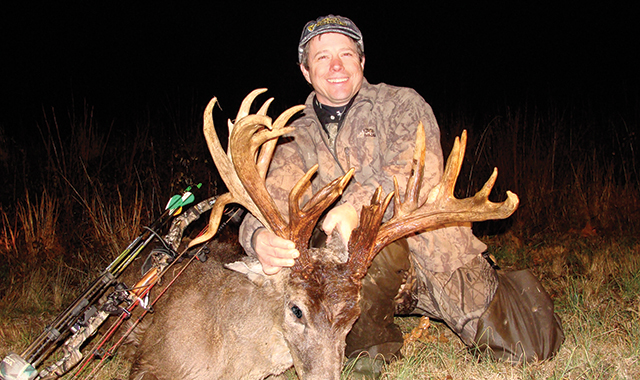 Whitetail fate played its hand for Arkansas’ Shane Frost on January 23, 2012. The setting was in the big-timbered, fertile ground of the Black River Bottoms in Clay County in northeast Arkansas. The ancient oaks and sloughs, in all their years, had likely never witnessed a more epic bowhunting scene.
Whitetail fate played its hand for Arkansas’ Shane Frost on January 23, 2012. The setting was in the big-timbered, fertile ground of the Black River Bottoms in Clay County in northeast Arkansas. The ancient oaks and sloughs, in all their years, had likely never witnessed a more epic bowhunting scene.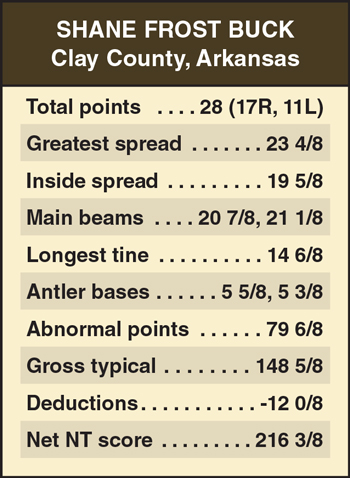 day in early November during the Arkansas Youth Season, an amazing find surfaced at the camp. Eight-year-old Cooper Lutz and his father were walking through the timber towards their stand when Cooper spotted a huge, broken antler. Upon inspection, Frost and several others from camp thought it might be the big non-typical. However, no one had a single picture of the buck in the fall of 2011, so they didn’t know what his new rack looked like! They could only guess that it was his antler.
day in early November during the Arkansas Youth Season, an amazing find surfaced at the camp. Eight-year-old Cooper Lutz and his father were walking through the timber towards their stand when Cooper spotted a huge, broken antler. Upon inspection, Frost and several others from camp thought it might be the big non-typical. However, no one had a single picture of the buck in the fall of 2011, so they didn’t know what his new rack looked like! They could only guess that it was his antler.






















































